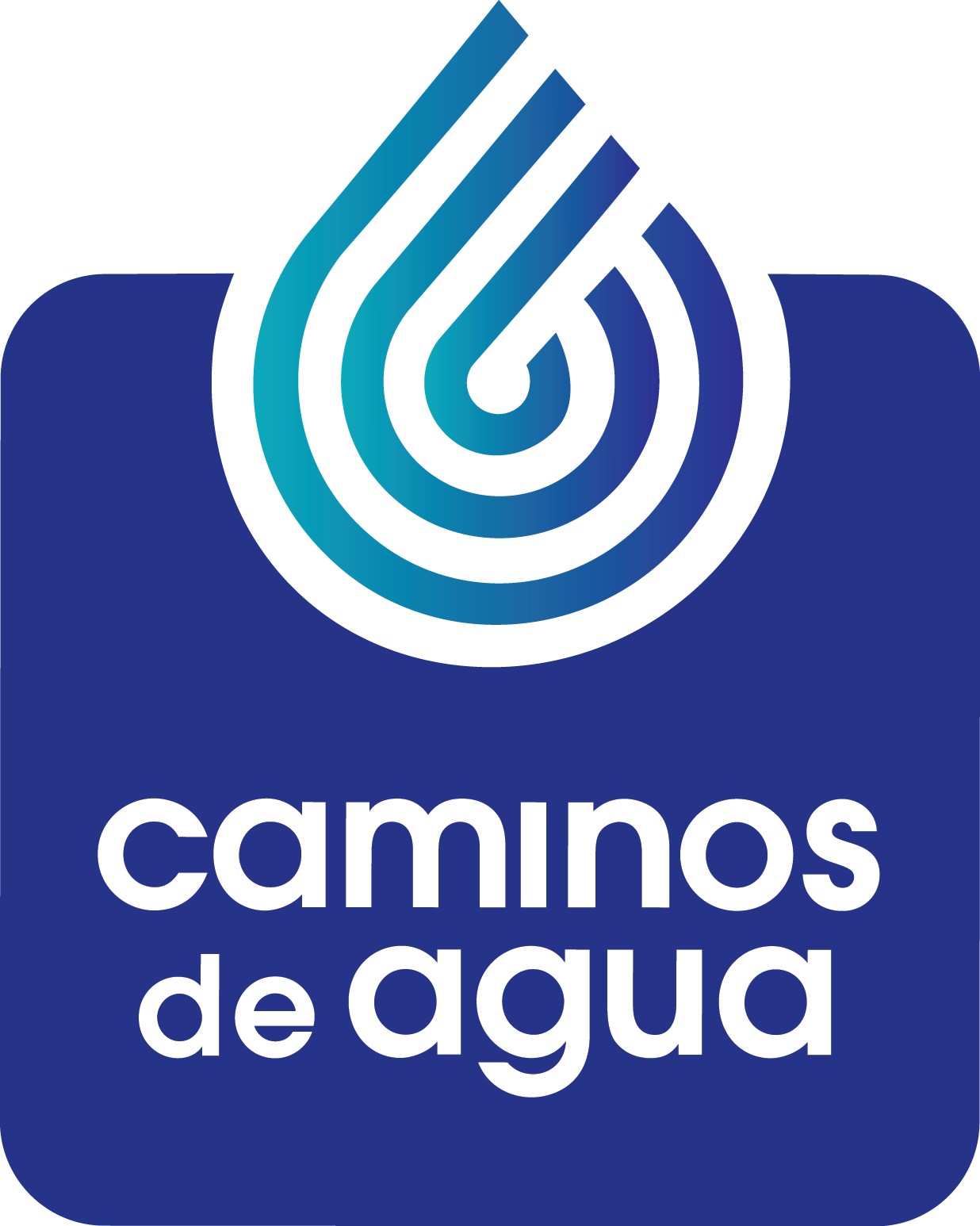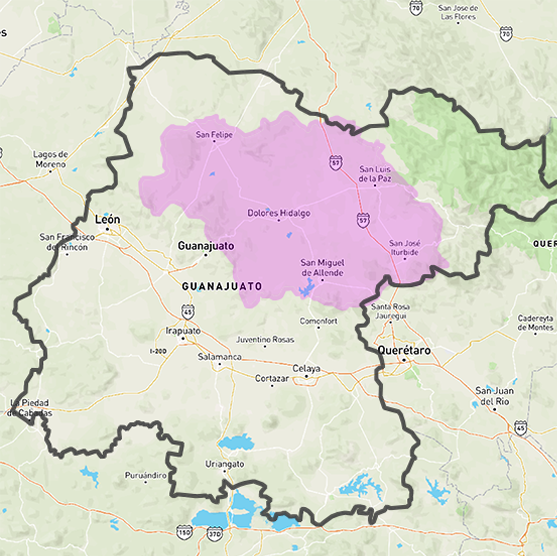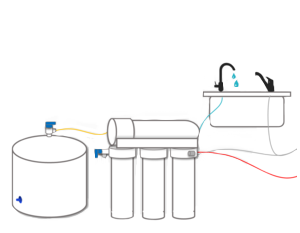What Can You Do To Have Safe Drinking Water?
Household Water Treatment Options for San Miguel and the Greater Region
Photo: The Upper Rio Laja Watershed pictured above (in pink) encompasses seven municipalities across Northern Guanajuato State.
Background: Regional Water Quality and Health
The Upper Rio Laja aquifer is a large groundwater reservoir and the main source of water in our region of northern Guanajuato stretching across more than 2,800 rural and urban communities and encompassing a population of more than 680,000 people. This water source has been relentlessly overexploited over the past decades, namely by large agro-industry for export, which uses 85% or more of our water resources. Because of this, the water table is decreasing by a staggering 2-3 meters (~6-10 feet) a year. This race to the bottom of our aquifer is producing dire environmental and health issues. The deeper we dig our wells in order to obtain this precious and life-sustaining resource, the more water is contaminated with arsenic and fluoride – two naturally occurring chemicals that are extremely dangerous to human health.
The long-term or excessive consumption of arsenic and fluoride via our drinking water causes is linked to severe health problems, such as dental and crippling skeletal fluorosis (irreversible brown stains on the teeth and deformed bones), skin lesions, learning and cognitive impairments in children, chronic kidney disease, and several types of cancer. The World Health Organization (WHO) states the maximum permissible limit for fluoride in drinking water is 1.5 parts per million (ppm or mg/L), and, for arsenic, the limit is 10 parts per billion (ppb or µg/L). In some of the rural and urban water we’ve tested, we have detected levels of fluoride and arsenic at 12 and 23 times above the WHO limits respectively.
It is important to note that arsenic and fluoride are only dangerous when consumed, that is, used for drinking or cooking. Health risks associated with using arsenic and fluoride contaminated water for bathing, showering, cleaning dishes, floors or surfaces, washing clothes, etc., are extremely low.
What is the Quality of Your Water?
Photo: Community leader taking a water sample from the community's well.
Water quality is not static. It varies throughout the region and also continues to change over time. Additionally, especially in urban areas like San Miguel de Allende, water quality in a given location can change much quicker than normal, sometimes even in a matter of days. This is because the local water authorities often mix waters from different wells in order to meet the population’s water demand. Because of this, we recommend always treating for arsenic and fluoride in your water, even if levels of those contaminants seem okay in your home today.
At Caminos de Agua, we sample water from rural communities consistently in order to understand these changes in quality and to track trends over time. For private or household water testing, we offer the service for a small fee to help support our social programs (you can consult prices by clicking here or visiting https://caminosdeagua.org/en/water-testing).
We publish all of our water quality results in both rural and urban locations for free on our website. So, if you are curious about the arsenic and fluoride levels throughout the region, or in your own colonia or community, please consult our Water Quality Map or visit https://caminosdeagua.org/en/water-quality-map.
Water Solutions You Can Use
It’s important to understand that most of the commercially available water treatment systems do not remove arsenic and fluoride. The majority of these systems are designed to remove biological pathogens and improve taste, but very few are capable of removing chemical contaminants like arsenic and fluoride. Popular options like “whole-house” water treatment systems (a combination of UV, sediment, and carbon), boiling water, adding chlorine, and even expensive Nikken filters, simply can’t touch arsenic and fluoride, which are completely dissolved in the water.
There are very few easily-available solutions able to deal with these contaminants. At Caminos de Agua, we promote three possible solutions:
Rainwater Harvesting + Biological Treatment,
Reverse Osmosis Treatment Systems, or
Commercial Bottled Water (e.g. garrafones) from a reputable source.
Rainwater Harvesting Systems
Diagram: Rainwater Harvesting System + Biological Treatment
We believe that harvesting, storing, and treating rainwater to remove biological pathogens is the most environmentally-friendly solution; however, all three options should give you consistent access to clean drinking water, free of arsenic and fluoride. Learn more about rainwater harvesting, access our rainwater harvesting calculator, and download our manuals and other education materials, on our website by clicking here (or visiting: https://caminosdeagua.org/en/rainwater-harvesting/#rwhresources
Reverse Osmosis Systems
Image: Diagram of a Reverse Osmosis System.
The only commercially-available treatment system in our region capable of removing arsenic and fluoride is a Reverse Osmosis (RO) treatment system. These systems can be installed in a couple of hours by an experienced plumber and require maintenance every 3-6 months. Please note that there are many systems that “look” like reverse osmosis but in fact are not. Ultrafiltration is NOT reverse osmosis. If you have any doubts, please contact us through our website with a picture of your system. If you already have an RO system Caminos offers a quick efficiency test that tells you how well your system is working (you can learn more by visiting https://caminosdeagua.org/en/water-testing).
Bottled Water
Image: Bottled Water or garrafón – a 20-liter capacity water bottle found commonly in Mexico.
We have tested many brands of commercial bottled water in our region and have never found any significant levels of arsenic, fluoride, or other contaminants. That said, numerous other studies have shown excessive levels of arsenic, fluoride, biological, and other contaminants in bottled water all throughout Mexico. In the future, and as resources allow, we plan on offering more information on local bottled-water companies and options. In the meantime, please be careful and only buy bottled water from reputable distributors, or contact us directly for up-to-date information and recommendations.
We recommend buying bottled water only while traveling or as a temporary option while more suitable alternatives are being considered. Rainwater harvesting and reverse osmosis easily pay for themselves in the long term. In fact, bottled water can easily be 100 times more expensive than your own in-house rainwater harvesting or reverse osmosis system. Additionally, bottled water has a much more harmful impact on the environment.
Mexico is the largest consumer per capita of bottled water in the world, contributing to our environmental problems. Bottled water companies are among the largest water users in Mexico, often contributing to the depletion of aquifers. These companies pay very little to extract and treat the water and ultimately sell it back to the public at an exorbitant mark-up.
Want more La Gota?
Our last issue of La Gota was about the impact of agriculture on our water supplies. Next month’s issue will look at the Ashoka Fellowship, our relationship to them, and how this will impact our work.
If you enjoyed this article, please consider making a donation by clicking on the button below:
Learn more and read past issues of La Gota at:
How Can YOU Obtain Safe Drinking Water?
Below is a list of water treatment options and alternative water sources. Check-marks indicate that the treatment option CAN remove those contaminants or the water sources is free of those contaminant







